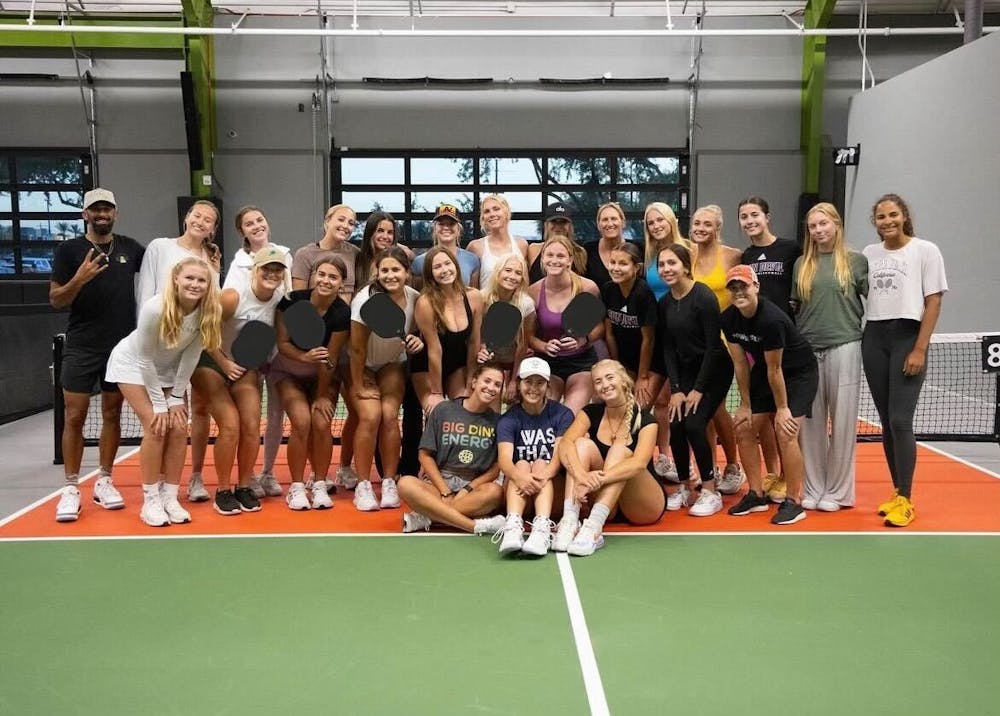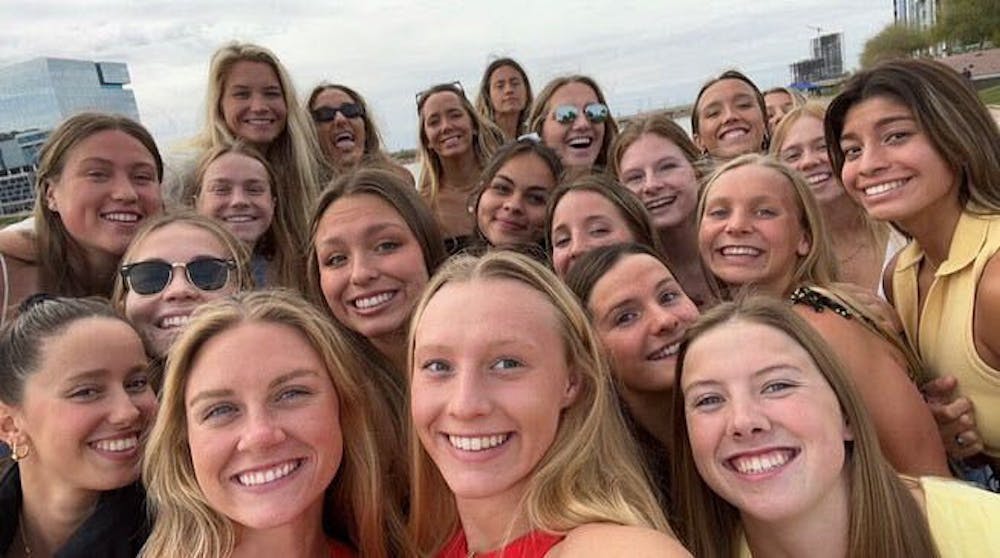After months of racing from class to class, hunkering down in the library and working nonstop, the highly anticipated Thanksgiving and winter breaks give stressed students a welcome reprieve.
Thanksgiving break, which took place from Nov. 23–24 this year, offers students a two-day intermission from classes before they cap off the semester with the last week of classes and finals week, which concludes on Dec. 9.
Then winter break begins, giving students the opportunity to travel away from campus until Jan. 8, 2024, when the spring semester kicks off.
These over four weeks of holiday celebrations can be a whirlwind of family, friends, food and festivities, completely free of academic pressures — a chance for students to finally catch their breaths.
But not for many student-athletes.
While much of the student body flees campus during the Thanksgiving and winter breaks, many student-athletes remain for team practices or sporting events.
Twelve ASU athletic teams’ seasons overlap with at least one of the two breaks: football, men’s and women’s basketball, men’s and women’s swim and dive, ice hockey, men’s and women’s golf, men’s and women’s tennis, wrestling and volleyball.
The women’s basketball team is scheduled to play a game against UA in the Territorial Cup series over winter break on Dec. 17 while ASU football played the Territorial Cup showdown, a school staple, the day after Thanksgiving break on Nov. 25.
This leaves these student-athletes with significantly less time to rest before another semester rounds the corner, perhaps robbing them of a traditional Thanksgiving dinner or holiday spent at home.
‘Tis the season to work out
Even though student-athletes don’t attend class during the breaks, this doesn’t mean their schedules aren’t still jam-packed with training.
From mid-November to New Year’s, the cross-country team will keep attending practices to “focus on strength with an introduction of speed work,” head coach Ryan Ray wrote in an email. “They will increase volume and add 2 workouts per week.”
While the swim and dive team doesn’t have any meets in December, the month marks the season’s midway point, a time when swimmers ramp up the intensity of their workouts.
The swim and dive team doesn’t take any days off for Thanksgiving, and it continues to practice its typical six days per week over winter break until Dec. 21, according to head coach Bob Bowman.
“[These practices are] by far the hardest practice[s] because [the swimmers] don't have school,” he said. “Once the exams are done, we'll kind of get into it, and there'll be, like, a solid month of really hard training.
“We look forward to that because that's where they really … make the most progress.”
After these intense weeks, there are six days when the team doesn’t have any practices scheduled, but most swimmers continue doing high-intensity workouts on their own, Bowman said.
“It's not much of a break for them,” he said. “After that brief break, the team restarts its normal practice schedule on Dec. 27.”
For some coaches, the offseason is the most important time of the year.
While winter teams use the break to prepare for matchups in the new year, spring sports, like softball and beach volleyball use this time to prepare for their first games of the season in January or February.
The beach volleyball team worked out roughly 20 hours per week until Thanksgiving but is enjoying a break from practices until January, according to Kate Fitzgerald, a beach volleyball player and senior studying biological sciences.
According to Matt Thurmond, head coach of the men’s golf team, the offseason is a time for student-athletes to “differentiate themselves from their competition.” Some spring-season teams don’t hold formal practices during the Thanksgiving and winter breaks, so it is up to the student-athletes to maintain a diet, practice schedule and workout routine.
“Over the years I’ve seen many come back [from break] very sharp, benefitting from an off-season of focused work,” Thurmond wrote in an email. “I’ve seen others come back flat and sloppy from lack of work.”
Though it’s crucial for student-athletes to remain in shape, Fitzgerald said finding motivation can be a challenge when all the other students are resting over break.
“I've had some winter breaks where I didn't want to look at the volleyball; I didn't want to look at a weight — I wanted to do my own thing,” she said. “I know that's why coaches, I'm sure, have the biggest frustrations with breaks.”
But she said this is just one of the “ups and downs” that come with being a student-athlete. To steer clear of distractions, she never lets her eye stray from her goals. Winter break doesn’t have to hinder student-athletes if they’re able to adapt their practice schedules, Fitzgerald said.
“I think so much of it is just building a lifestyle around [winter break practices],” said Herbie Behm, associate head coach of the swim and dive team. “You kind of get into a routine of training, sleeping, eating well.”
Behm isn’t one to advocate for strict diets or cutting back holiday treats over the breaks. He wants his swimmers to enjoy a holiday feast too — in moderation. But he said they should never take a break from workouts, as it’s nearly impossible for student-athletes to return in January with the edge they had when they left if they completely stop working out. The body requires a level of consistency with practicing and working out to stay in shape.
“One step forward, one step forward,” Behm said. “We want to at least stay in the same spot over the holidays.”
‘We don’t have a normal holiday’
For swimmer Andy Dobrzanski, a sophomore studying construction management and technology, winter break is filled with countless practices, team meetings and workouts, even when he travels home to Monroe, Michigan. Though it’s a hiatus from his obligations in the classroom, the grind in the water never stops.
“I get only a week [to visit my family],” Dobrzanski said. “But I mean, it is what it is, and it’s just about all the training.”
During his weeklong trip, Dobrzanski may be nearly 2,000 miles away from ASU’s Mona Plummer Aquatic Center, but he’s never really away from his coaches. He still follows their intense workout schedule, even on Christmas Eve. Like many other swimmers, Dobrzanski practices with his hometown’s club or high school team when he’s visiting his family.
Yet the breaks — although brief — still provide student-athletes a needed “reset” from classes and their normal practice schedule, Fitzgerald said.
“It allows you to come back more excited to play again,” she said.
Fitzgerald spends winter break in her hometown of Scottsdale with her friends and family, but practice never stops. She continues to work out with her coach, and she’s also able to access ASU’s facilities.
For some student-athletes, including Fitzgerald, winter break is also a time to mentally de-stress and avoid burnout.
After nearly four years of intense team practices and workouts galore, Fitzgerald said allocating time for activities outside sports and school helps add balance to her busy beach volleyball life.
“It can get repetitive [doing] the same thing every day, five days a week, and the same workouts,” Fitzgerald said.
During winter break, when she isn’t working out, she bakes holiday treats, unwinds by the fire and spends quality time with her family. She doesn’t allow the break to overturn her practice schedule, but she still comes back in January feeling refreshed.
“It's the holidays,” Fitzgerald said. “I'm going to have a Christmas cookie. I'm going to sit down and have hot chocolate with my family by the fire. I'm not going to be like, ‘Oh no, this is ruining my possibility of playing.’”
The practice-free days of Dec. 21-26 are some of the swimmers’ busiest, as they must cram family time, hangouts with hometown friends, holiday festivities and practices into just six days. For Zoe Summar, a swimmer from Franklin, Tennessee, the time spent at home seems to fly by even though time may slow to a crawl for other students.
“I'll go home, and my friends are like, ‘Oh my gosh, I'm ready to go back to college. We've been home for a month now,’” the sophomore studying kinesiology said. “I'm like, ‘Alright, this is my second day at home, and I leave in three days. That is not what I needed to hear.’”
Visiting her family during break allows her to return to hometown comforts she’s far away from during the semester.
“It's a short amount of time, but it's also a nice little reset to be with family and to get to train at home, do what you need to do, eat the good home-cooked food,” Zoe said.
The hustle and bustle of the holidays cuts into the time the swimmers can spend with their families, according to Tammy Summar, Zoe’s mom. “That … six days they’re home is pretty rushed,” Tammy said.
But regardless, Tammy tries to prioritize seeing “the center of [her] world” as much as possible.
“There were … traditions that we probably don't get to do because [Zoe’s] only home for a short period of time, like shopping and … cooking and just little baking cookies,” she said.
Though Zoe and Fitzgerald continue working out, they aren’t upset that they don’t enjoy the breaks in the same way as other ASU students. Both said the hours they spend working out can make winter break feel brief, but it is family, friends and relaxation time nevertheless.
“I think it just makes you really thankful for the time you have at home because … it's short, but you cherish it,” Zoe said.
Creating their own family
During the weeks leading up to the swimmers’ six-day break, Zoe and the rest of the team stay in Arizona. During her first winter break at ASU, Zoe remained in student housing, even as many other residents fled campus.
“It was really weird — walking down, and you're the only people at lunchtime,” she said.
For student-athletes living on campus, the homesickness they feel for their families by the holidays only compounds the loneliness.
“I think that's the hardest part of being a student-athlete during the holiday season, is everyone's at home,” Zoe said. “I am just really close to [my family], so I do miss them a lot during the holiday season.”
To help foster a sense of community, the swim team hosts dinners and group outings during the break — bonding time they may not have during the rest of the season.
When Tammy visits Arizona, she rents an Airbnb for Zoe and the rest of the women’s swim team, where she’ll act as the “team mom” by whipping up home-cooked meals.
“It was fun to see and get to know everybody,” Tammy said. “We like seeing them with dry hair. It's like, ‘Oh, okay, now I know who you are.’”
Last year, the women bonded by making and decorating pizzas. “That's those little things that make you feel at home even though you're not there,” Zoe said.
For Fitzgerald, the beach volleyball team’s outings remind her it’s a “second family.” The team celebrates over the breaks with Secret Santa gift exchanges and holiday dinners, like Friendsgiving.
“It brings everyone back together,” Fitzgerald said. “Hanging out with one another … outside the area of competition, … I think that's really important.”
But there are numerous international student-athletes who won’t travel home during the breaks. Though they too may long for home, they may not have the means to amid high airfare prices and their busy schedules.
During the 2021-22 academic year, out of ASU’s over 650 student-athletes, 90 were international. It can feel isolating for them to stay alone in the States when they could be celebrating the holidays in their home countries with their families according to their traditions.
Luckily, team outings can be a small, yet meaningful, way for them to also share in the holiday joy.
“The international students who don't get to go home at all, … it helps them have a home-cooked meal,” Zoe said. “These girls are … like … my sisters.”
Edited by Camila Pedrosa, Savannah Dagupion and Madeline Nguyen
This story is part of The Immunity Issue, which was released on Nov. 29, 2023. See the entire publication here.
Reach the reporter at zabradsh@asu.edu and follow @ZachBradshaw14 on X.
Like State Press Magazine on Facebook, follow @statepressmag on X and Instagram and read our releases on Issuu.







